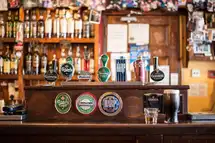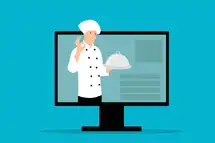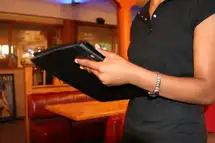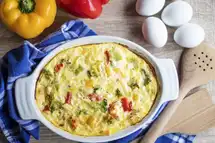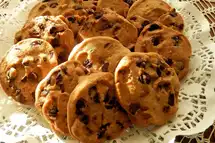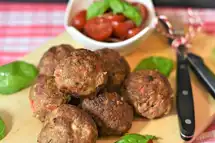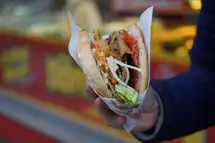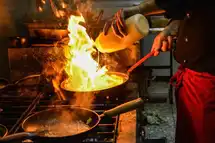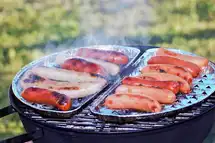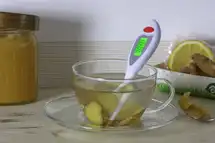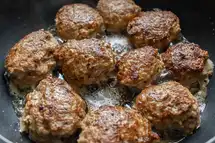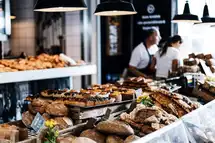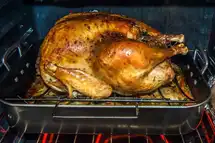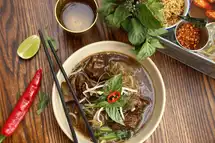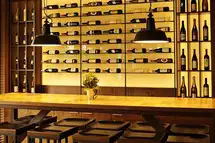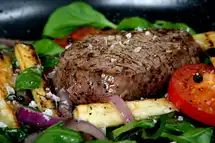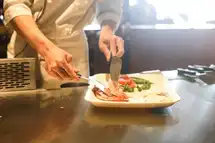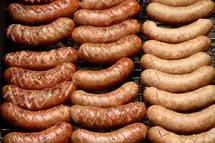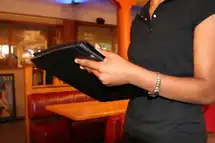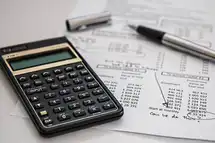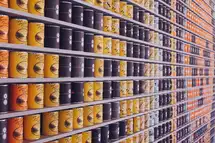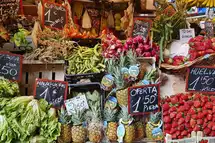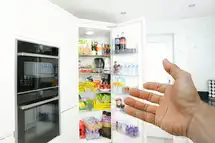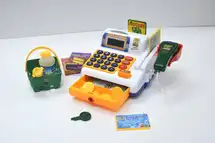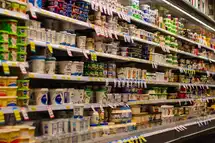What is a kitchen thermometer?
A kitchen thermometer is a tool that helps you measure the temperature of food. It is important to use a kitchen thermometer to make sure that food is cooked properly and to avoid foodborne illness.
5 Different Kitchen Thermometers and Their Uses (+Buyer's Guide)
What is a Kitchen Thermometer?
How do you ensure your food is safe for consumption? A sure-shot way to do so is to maintain proper food temperature while cooking, holding, reheating, and storing. Disease-causing germs proliferate quickly at mid-range temperatures and food should not be allowed to sit in such hazardous temperature zones.
Within the temperature control boundaries set by food safety requirements, you also have to be mindful of the fact that your recipe may call for cooking your food to a higher or lower degree to achieve varying levels of doneness.
While you cannot determine if your food is free from pathogens just by touching, smelling, or looking at it, relying on guesswork to decide whether you have cooked your food to the desired degree will invariably cause you to under- or overcook your food.
You, therefore, need a more concrete way to monitor the temperature of your food, and even the ambient temperature of the cooking apparatus. A kitchen thermometer provides you with that option. Reading the temperature off a food thermometer ensures that there is no scope for ambiguity in your cooking and that you are following hot/cold holding and reheating norms as prescribed.
There are various types of kitchen thermometers catering to different cooking/storage techniques, different ingredients, different cooking equipment involved, and different temperature ranges. There are meat thermometers, candy and deep fry thermometers, instant-read thermometers, grill thermometers, smoker thermometers, barbeque thermometers, oven thermometers, and refrigerator thermometers you can use.
Thermometers also vary in terms of the technology they employ. So there may be simple analog thermometers at one end of the spectrum, Bluetooth and Wifi food thermometers at the other end, with basic digital thermometers in between.
Thermometers also come in different sizes and shapes, from open-face dial, fork, bulb, to prong thermometers.
How is a Kitchen Thermometer Useful?
As mentioned, a kitchen thermometer helps you keep food out of the temperature danger zone, which is extremely important to ensure that your food is safe.
The Food Safety and Inspection Service (FSIS)an agency of the United States Department of Agriculture (USDA)identifies the food temperature danger zone as between 40 F and 140 F. It is this temperature range in which bacteria can double in just 20 minutes.
ServSafe, the food safety training body of the National Restaurant Association, on the other hand, fixes the temperature danger zone at 41-135 F.
Within the broad temperature ranges identified as the danger zone for food, the range from 70 F to 125 F is where the threat from disease-causing pathogens is the maximum.
A kitchen thermometer becomes vital in ensuring that food items are cooked to their recommended safe minimum internal temperatures. This may vary from one type of food to another. For example, pork chops require an internal cooking temperature of 145 F, while ground poultry needs 165 F.
Thermometers are also necessary to ensure that food is hot-held at temperatures higher than the hazardous range (that is beyond 140 F). They also ensure that food is cold-held at temperatures lower than the hazardous range. Accordingly, the food needs to be refrigerated at 40 F and below, and frozen at 0 F and below.
Thermometers also tell you if the ambient temperature of the place where food is kept has climbed above 90 F. This would require you to transfer the food to a refrigerator within an hour. Thermometers also let you know if cold food items have notched 70 F or more, making them unfit for consumption.
When reheating food, you need to ensure that it reaches an internal temperature of 165 F.
Thermometers help you cook to perfection, making sure your food conforms to recipe requirements, be it medium rare (145 F), medium (160 F), medium-well (175 F), or well-done (180 F). Moreover, if you are into the confectionary business, you need to monitor temperatures as high as 300-400F.
Thermometer accuracy can be checked in the following ways-
- The ice water technique requires you to fill up a glass with cold water and ice cubes, and when the thermometer probe is dipped into the ice water, it must display the freezing point of water (32 F).
- In the boiling method, distilled water is boiled in a pot and the thermometer is dipped into the pot once the water reaches a rolling boil. The temperature displayed should equal the water's boiling point (212 F).
Not all kitchen thermometers are built the same.
This guide introduces you to the different types to help you make the right choice for your kitchen.
Types of Kitchen Thermometers- Meat Thermometers
Meat thermometers help you monitor the temperature of meat or poultry during roasting, grilling, smoking, or barbequing. The probes can be left in the food, allowing you to continuously monitor temperatures during the cooking process. The probes can stay in the meat even after it is taken out of the oven. This will help track the Meat Temperature during the rest period. Bluetooth or Wifi meat thermometers are designed for this function.
You may alternatively take split-second readings at specific points of the cooking process using instant-read meat thermometers. Meat thermometers can be employed to gauge the temperature of the smoker/grill as well.
Digital meat thermometers can be programmed in such a way that they notify users when target temperatures are hit. Temperature probes are joined to oven-proof wires attached to the main thermometer unit. The thermometer can be mounted on the outside part of the oven and held in place with the help of a magnet.
Wireless, Bluetooth, and Wifi thermometers are highly sophisticated. Wireless/remote meat thermometers refer to appliances that wirelessly link with other devices. A wireless thermometer consists of probes linked to a transmitter. As the meat cooks, temperature readings are sent to the receiver (a smartphone app or a remote).
Bluetooth thermometers are wireless thermometers that use short-range radio frequencies to communicate with devices like smartphones, tablets, and computers. Wireless/Bluetooth thermometers, therefore, spare cooks the trouble of having to stay put near the grill or oven to monitor the cooking. You can do it from a distance, even as you multitask. All you need to do is check your phone from time to time, and be alert to notifications sent by the smart thermometer.
Bluetooth thermometers have to be inserted into the thickest portion of the meat, with care taken to avoid gristle or bone.
Wifi meat thermometers offer even greater advantages. Unlike Bluetooth thermometers, Wifi thermometers can be linked directly to the internet and can store data in the cloud. This gives Wifi thermometers an unlimited range, with cooking monitored from any place in the world, and records of cooks maintained for future reference.
Some of the top meat thermometers are the Thermoworks Signals, ThermoPro TPmeat thermometer, Meater Plus, Weber iGrill2, and Flame Boss Wifi thermometer.
Oven Thermometers
The temperature inside an oven cannot be reliably read from an oven dial. When your oven is set to 350-400 F and the oven dial displays that temperature, the actual temperature could be 25-50 F off the mark. What's worse, there may be cool and hot spots inside the oven. These areas with temperatures lower or higher than other parts of the oven adversely affect baking time.
The oven thermometer can be placed on a shelf, or hung from an oven rack. To check the actual oven temperature, set the oven to, let's say, 350 F. You would know from the oven thermometer if the temperature is actually what you had set, that is 350 F. If the thermometer consistently displays a value, let's say 25 F higher than what was set, and if you are confident about the accuracy of your thermometer, you need to adjust the oven accordingly. Therefore, if your recipe calls for baking at 350 F, you need to set your oven to 325 F.
Certain oven thermometers can measure extremely hot temperatures, allowing them to be used for grilling as well. These thermometers ensure that guesswork is dispensed with so that you don't end up burning your food or undercooking it.
Some of the best oven thermometers are the KT Thermo three-inch dial oven thermometer, Cooper-Atkins 24HP HACCP dial oven thermometer, Winco three-inch dial oven thermometer, Rubbermaid oven thermometer, and Cooper oven thermometer.
Instant-read Thermometers
Instant-read thermometers are easy to use and offer immediate Food Temperature readings that would, for example, tell you exactly when to take the turkey off the grill, and if the food has been cooked to a safe temperature. With these thermometers, you don't need to wait to get a temperature reading, nor do you have to check the doneness of the meat manually.
Instant read probe thermometers can be either digital or analog, but unlike Bluetooth thermometers, cannot be left in the food while it is cooking. These thermometers simply need to be inserted into the food and then removed to get a temperature reading.
What instant-read thermometers lack in hi-tech features, they make up for in their simplicity.
Food Safety can be ensured by employing instant-read thermometers to gauge the temperature of hot meals in a chafing dish or steam tray, and that of cold food in a salad bar. Thermometers can also tell you how fast a sauce or soup is cooling so that it doesn't lie in the food temperature danger zone for too long.
Some high-quality instant-read thermometers include the Lavatools Javelin PRO Duo, ThermoWorks ThermoPop, Habor instant-read thermometer, OXO Good Grips instant-read thermometer, and ThermoWorks Thermapen One.
There are so many types of kitchen thermometers in the market, how do you know which to buy?
This blog provides you with a set of buying tips to help you out.
Candy and Deep-fry Thermometers
These are narrow and long glass thermometers designed to measure extremely high temperatures of boiling sugar, sauces, oils, and syrups.
To put things in perspective, the temperature to be measured while cooking meat and poultry may range from 145 F to 180 F, but making candy requires sugar to be cooked to more than 300 F. Deep-frying involves heating oil to 375 F and more.
Exact temperatures determine the final form and malleability of the candy, and help confections such as caramels, spun sugar, brittles, and sugar syrups in reaching their right consistency.
Likewise, while deep frying, you need to ensure that the oil is not too cool, which could make the food greasy. The oil should not be too hot either, because the oil may then begin to smoke and could even catch fire.
You may have separate deep-frying and candy thermometers, but usually, the two are combined and serve home cooks well. These thermometers typically come with clips to secure them to the pot.
Polder candy/jelly/deep fry thermometer, Taylor precision products candy/deep fry thermometer, Williams Sonoma Bluetooth candy thermometer, OXO Good Grips glass candy and deep fry thermometer, and GoodCook Classic candy/deep-fry thermometer are some of the notable candy and deep-fry thermometers available in the market.
Refrigerator Thermometers
Refrigerator thermometers are the most accurate and cost-effective way to maintain the proper temperature in your fridge and freezer. Appliance thermometers are particularly useful, given that there are only a handful of refrigerator controls that show true temperature.
In order to check your refrigerator temperature, place the thermometer in a glass of water, and put the glass at the center of the refrigerator. Wait for around five to eight hours. You need to adjust your refrigerator controls if the temperature falls outside the 38-40 F range. Calibrate the controls and then check again after around five to eight hours to make sure that the refrigerator is functioning smoothly.
The process for checking the freezer temperature is largely similar, but here, you need to push the appliance thermometer between food packages. The temperature control has to be calibrated to read 0-2 F.
Refrigerator thermometers must be waterproof and have anti-fog displays because they operate in an environment full of moisture.
ThermoWorks fridge/freezer thermometer, Rubbermaid refrigerator/freezer thermometer, Taylor Pro Series digital fridge/freezer thermometer, AcuRite refrigerator thermometer, and VOULOIR fridge thermometer and options to check out.
Features to Look For a Kitchen Thermometer
1. A food thermometer must display true temperature readings. If the readings displayed are not the actual temperatures, you will not be able to ensure Food Safety and food quality. You may believe your meals are cooked/maintained at the right temperature when they are not, leading food to be undercooked or overcooked. Moreover, if you cannot maintain the recommended temperature while hot holding, reheating, refrigerating, and freezing, food may spoil from the action of pathogens. If you are a food business, poor food quality that results from relying on faulty thermometers may tarnish your public image, and shrink your revenue.
2. A related point is the fraction of a degree a thermometer can gauge. Most food thermometers can read up to a tenth or up to a hundredth of a degree. The latter variant is the more precise thermometer. A thermometer that displays one digit following the decimal, measures temperatures up to a tenth of a degree. Two digits following the decimal, mean that the thermometer measures temperatures up to a hundredth of a degree.
3. Thermometers should not show different readings on different occasions when measuring the same element. So for instance, if your thermometer reads the temperature of a 32 F ice bath as 32 F once, 35 F the second time, and 30 F on the third occasion, you'll know something is amiss about the measurements.
4. The thermometer should have a good enough temperature range so that it can measure extreme food temperatures. For instance, as mentioned in one of the earlier sections, you need to measure nearly 400 F while making candy. Moreover, the temperature of frozen food can fall below a thermometer's standard minimum range, while the temperatures of certain smoked meats can go beyond the thermometer's standard maximum range.
5. Your food thermometer should be able to give you quick temperature readings. Slow thermometers can spoil the cooking, especially when temperature-sensitive food items are involved. Electronic thermometers usually provide the quickest readings.
6. Thermometers should be able to maintain a record of temperatures throughout the cooking process, and send notifications if things go awry.
You think a kitchen thermometer is a waste of money.
This blog shows you why a kitchen thermometer is one of the most important tools you can have in your kitchen.


